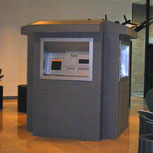In “Junkspace”, Rem Koolhaas” contribution to the Spring 2002 issue of October, the author describes in broad, at times metaphorical terms, what he perceives to be a global cultural crisis; he describes Junkspace as “the body double of space, a territory of impaired vision, limited expectation, reduced earnestness.”
A result of rampant growth in practically all areas of human consumption, a collapsing of visual vocabularies as well as spoken language, and the uniformity and subsequent deadening of both public and private spaces, Junkspace is as much a general description of a blurry architectural catastrophe as it is a qualification of specific situations.
Ester Partegàs” installation Samesation, while addressing the same kind of impersonal and redundant environment as Koolhaas, avoids overt evaluation in favor of a fairly straightforward formal re-enactment. Created entirely out of mat-board and assembled in a modular fashion that allows each element to be easily dissembled, folded and transported, the installation is a collapsible replica of a plaza/airport/lobby cash machine in its characteristic locale — a consumer place-type that, as a result of its ubiquity and its singularity of purpose, paradoxically seems both invisible and oddly conspicuous. The oversized ATM is flanked by trees, plants, and round benches, each constructed from similar, angular planes and shapes. Like a liposuctioned and loofah-ed actress portraying an average-looking person “in a story based on real-life events,” Samesation is a prettier, streamlined, inauthentic version of a quotidian subject.
While the work at first appears perplexingly impartial as to the consumer spaces it represents, Samesation‘s strength ultimately lies in its inherent contradictions: it is approachable but austere, unthreatening yet dreadful, an individual, handcrafted version of the commercial and the mundane. The exaggerated size of the elements in the installation (roughly 1.3:1) could be construed as a less-than-subtle metaphor for the oppression of individuals by their surroundings or by commerce itself; but their scale also creates a theatrical, funhouse atmosphere. The trees and plants, essentially reduced to the aesthetic vocabulary of the ATM, are both beautiful and unapologetically fake, underscoring our confused relationship to the already ambiguous concept of artificiality.
One of the most compelling aspects of Samesation is its link to new models for discrete consumer and social environments. The parceling out of specific areas for separate functions has been hardwired into our ‘social imaginary” of the future, and, as we become more and more acclimated to dedicated spaces such as the gated community, the mall, the gym, and the cinema multiplex, the terminology that corresponds with this specificity has become a significant component in marketing tactics (e.g, Sony PlayStation, ESPN’s SportsZone, Powerbar’s “Energy Stations”). As much as this language connotes a singularity of action and purpose, it also reflects a seriousness of that purpose, and the soft sell and hard aesthetics of Samesation evoke a suspicion of the emphasis our culture places on “taking care of business.” The installation elicits questions regarding individual power and varying degrees of complacency in the context of a society that is centered increasingly around the efficiency — and, for some, the comfort — of franchise.
Partegàs is not alone in her consideration of current approaches to the development of public and commercial spaces; artists such as Benjamin Edwards and Sven Pahlsson have also recently exhibited work that seems to address a shift in our understanding of location and an unease about the diminishing of both urban centers and distinct architectural modes. While Partegàs has chosen to provide us with a lone “anyplace,” Edwards and Pahlsson manifest repetition and standardization by folding particular types of structural elements into composites (in Pahlsson’s work, as computed-generated landscapes of urban sprawl, and in Edwards”, a sandwiching of various places into a single painted image.)
That several artists are concurrently addressing these themes may be indicative of more widespread concerns regarding commercial development strategies and a nostalgia for individuation and idiosyncrasy, but, interestingly, their observations are manifested in different ways: while Pahlsson’s work is engaged in a critique of its subject, Edwards and Partegàs appear more neutral. The apprehension of Koolhaas and Pahlsson is inarguably well-founded and the vehicles they use to express it are thoughtful and absorbing, but works like Samesation are equally valuable for their ability to provide alternate means for examining a complicated issue. By avoiding explicit finger-wagging, Partegàs has provided a structure in which to reflect on both our anxiety about the dissolving of local aesthetics and the guilty comfort that comes with knowing exactly what to order when we run to the Starbuck’s at the airport — any airport.
Images courtesy the artist and Rice University Art Gallery.
Hilary Wilder is an artist and a writer-in-residence with the Core Program at the Glassell School of Art in Houston, Texas.



